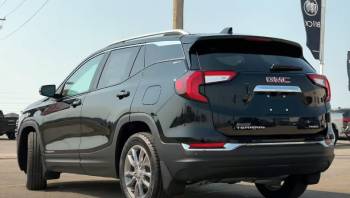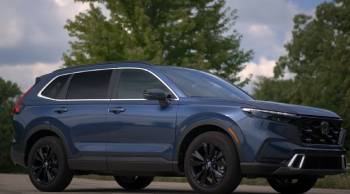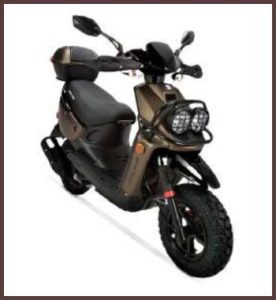The SUV market is vast, with many brands boasting their own champions. Among them, the GMC Terrain and Honda CR-V are two noteworthy competitors. Each has its own set of fans and loyalists, but how do they truly stack up against each other?
Let’s break it down.
A Brief Comparison Table
| Feature/Aspect | GMC Terrain | Honda CR-V |
| Exterior Design | Bold, aggressive with sharp lines | Modern, conservative with gentle curves |
| Engine Options | Turbocharged four-cylinders | Turbocharged four-cylinder |
| Drive Feel | Balanced with a hint of sportiness | Smooth, comfortable, predictable |
| Interior Design | Stylish with premium materials in higher trims | Utilitarian, practical, spacious |
| Technology | Touchscreen infotainment, Apple CarPlay, Android Auto | User-friendly infotainment, Apple CarPlay, Android Auto |
| Safety Features | Forward-collision alert, lane-keeping assist | Honda Sensing suite, collision mitigation |
| Cargo Space | Adequate but slightly less than CR-V | Generous, among the best in class |
| Starting Price | Generally higher | Lower, offering good value |
The Undeniable Pros of the GMC Terrain:

- Stylish Aesthetics
The Terrain, without a doubt, is a looker. Its bold lines and premium detailing make it stand out in the sea of SUVs.
- Tech-Loaded Interior
Expect modern amenities like a touchscreen infotainment system, Apple CarPlay, Android Auto, and a Wi-Fi hotspot.
- Advanced Safety Features
Safety is a priority. With features like forward-collision alert and lane-keeping assist, Terrain is committed to keeping its passengers safe.
- Towing Capacity
The GMC Terrain comes with a decent towing capacity, ensuring you can haul those weekend toys or a small trailer with ease.
Cons of the GMC Terrain:
- Pricier Entry Point
Compared to its peers, the Terrain starts at a slightly higher price point.
- Fuel Efficiency
Though not drastically inefficient, it doesn’t quite match the likes of the Honda CR-V when it comes to fuel economy.
Read More: About Nami Windows
Honda CR-V’s Strong Suits:

- Reliability
Honda has a longstanding reputation for building cars that last, and the CR-V is no exception.
- Spacious Interiors
With ample room for both passengers and cargo, the CR-V ensures everyone and everything fits comfortably.
- Fuel Economy
The CR-V is known for its impressive fuel efficiency, making it an excellent pick for long drives.
- User-Friendly Tech
With its intuitive infotainment system and controls, even the least tech-savvy person will feel at home.
Where Honda CR-V Falls Short:
- Less Aggressive Styling
For those looking for bolder aesthetics, the CR-V might come across as a tad vanilla.
- Base Model Limitations
The base variant can feel a bit stripped down in terms of features when compared to competitors.
Analytical Perspective: GMC Terrain and Honda CR-V
When dissecting these two vehicles from an analytical standpoint, it’s essential to acknowledge their target audiences. The GMC Terrain seems to be aimed at those who appreciate a touch of luxury and assertive aesthetics. The Honda CR-V, on the other hand, caters to those who prioritize reliability, space, and overall value.
While both cars have their strengths and weaknesses, the decision ultimately boils down to personal preferences and priorities.
Key Differences Between GMC Terrain and Honda CR-V
In the world of compact SUVs, the GMC Terrain and Honda CR-V may both cater to families and urban dwellers, but they have distinct differences that make them unique. Here, we dive into a detailed comparison of their features, performance, interiors, and more.
- Exterior Design and Styling:
GMC Terrain:
GMC’s Terrain offers a more aggressive and chiseled look. The front grille is bold, flanked by sharp LED headlights. The body features sculpted lines, giving it a robust and rugged stance. The floating roof design and C-shaped tail lights add to its distinctiveness.
Honda CR-V:
In contrast, the CR-V sports a more conservative yet modern design. The front fascia is characterized by broad LED headlights and a chrome grille. Its curves are gentler than the Terrain’s, leading to a more understated elegance.
- Performance and Drive:
GMC Terrain:
The Terrain’s engine options include turbocharged four-cylinders that provide ample power for daily drives. It offers a balanced ride and precise steering, making it feel somewhat sporty. An added bonus is its towing capacity, which outclasses many rivals.
Honda CR-V:
CR-V’s performance is built around efficiency and reliability. It offers a comfortable ride with its turbocharged four-cylinder engine being responsive and punchy. The CR-V is not necessarily sporty but offers a smooth, predictable driving experience.
- Interior and Comfort:
GMC Terrain:
Terrain’s cabin boasts a stylish design with premium materials, especially in higher trims. It’s tech-loaded, featuring a touchscreen infotainment system and a bevy of connectivity options. The interior is spacious, though cargo space might be a tad less than the CR-V.
Honda CR-V:
Honda offers a more utilitarian interior. The materials feel high-quality, and the layout is practical. The CR-V shines in terms of cargo space, easily outpacing the Terrain. The infotainment system is user-friendly, and the cabin feels airy and spacious.
- Safety and Technology:
GMC Terrain:
GMC has equipped the Terrain with several standard safety features like forward-collision alert and lane-keeping assist. Higher trims come with additional features like adaptive cruise control and blind-spot monitoring.
Honda CR-V:
The CR-V boasts the Honda Sensing suite of safety features, which is comprehensive and includes collision mitigation braking and road departure mitigation. Technology-wise, both vehicles are neck and neck, though Honda’s infotainment system may be more intuitive for some users.
- Price and Value:
GMC Terrain:
Generally, the Terrain has a higher starting price than the CR-V. However, it tries to justify the price with bolder aesthetics and a more upscale feel in terms of both design and materials.
Honda CR-V:
The CR-V offers excellent value for its price. Though its starting price is typically lower than the Terrain’s, it doesn’t skimp on features or quality, ensuring buyers get a reliable, efficient, and spacious SUV.
Also Read: Differences Between Diesel Pro And Stealth Modules.
Frequently Asked Questions (FAQs):
“Better” is subjective. GMC leans more towards luxury and bold design, while Honda is known for reliability and value for money.
Apart from the Honda CR-V, the GMC Terrain competes with SUVs like the Ford Escape, Toyota RAV4, and Chevrolet Equinox.
Yes, for those looking for a mix of style, technology, and safety features, the GMC Terrain is a commendable choice.
In the GMC lineup, the GMC Acadia is larger than the Terrain. In the broader market, SUVs like the Ford Explorer and Honda Pilot are bigger.
While the GMC Terrain has several luxury-like features and a premium feel, it’s more aptly described as an upscale mainstream SUV rather than a full-fledged luxury vehicle.
The GMC Terrain is an SUV, specifically falling into the compact crossover SUV category.
Conclusion
From the aforementioned points, it’s evident that while both vehicles excel in different domains, the choice essentially boils down to what an individual values most in an SUV. Whether it’s the stylish allure of the Terrain or the dependable charm of the CR-V, both cars offer unique experiences worthy of consideration.
To conclude, both the GMC Terrain and Honda CR-V are stellar in their own right. Your choice hinges on what you prioritize more – the upscale, assertive feel of the Terrain or the consistent, reliable nature of the CR-V. Either way, you’re in for a treat!



